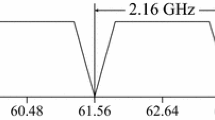Abstract
In the directional carrier sense multiple access-collision avoidance (directional-CSMA-CA) mechanism, the efficient channel access mechanism with a collision-controlled concept is one of the most challenging topics. Especially, in capillary machine-to-machine (M2M) where wireless personal area network (WPAN) is a key technology for its wireless connectivity, a contention-based medium access control (MAC) protocol is crucial to enable numerous M2M devices to concurrently access the channel. This paper presents an analytical model for the slotted directional-CSMA-CA mechanism of 802.15.3c networks under saturated environment. By presenting a multi-class approach of directional-CSMA-CA mechanism to reduce collision occurrences, we support an adaptive back-off exponent of M2M device on the required frame payload size. For the mathematical analysis, the discrete-time Markov chain model is applied with the features of PHY/MAC of millimeter Wave (mm-Wave) network and the effects of directional antennas. In addition, extensive simulations are performed to verify the analytical model. The obtained results of the analytic and simulation show that the collision probability of M2M device is reduced by differentially adapting the contention rate to each M2M device, and the fairness property can be improved because there are remarkable increases of opportunities to transmit short-frame payloads.










Similar content being viewed by others
References
Liu Y, Yuen C, Chen J, Cao X (2013) A scalable hybrid MAC protocol for massive M2M networks. IEEE WCNC 2013:250–255
Park H, Kim W, Pack S (2012) A deterministic channel access scheme for multimedia streaming in WiMedia networks. In: Proceedings of wireless network, vol 18, issue 7. Springer, New York, pp 771–785
IEEE Std. (2009) Amendment to part 802.15.3c: wireless medium access control (MAC) and physical layer (PHY) specifications for high rate wireless personal area networks (WPAN): Amendment 2: Millimeter-wave-based alternative physical layer extension
IEEE Std. (2013) Amendment to Part 802.11ac, IEEE standard for information technology-part 11: wireless LAN medium access control (MAC) and physical layer (PHY) specifications amendment 5: TV white spaces operation
IEEE Std. (2012) Amendment to part 802.11ad, IEEE standard for information technology-part 11: wireless LAN medium access control (MAC) and physical layer (PHY) specifications Amendment 3: Enhancements for very high throughput in the 60 GHz band
WiMedia Alliance (2010) ECMA-387 high rate 60 GHz PHY, MAC and HDMI PALs standard. ECMA, 2nd edn
Cai LX, Cai L, Shen XS, Mark JW (2010) REX: a randomized exclusive region based scheduling scheme for mm-Wave WPANs with directional antenna. IEEE Trans Wirel Commun 9(1):113–121
Bazan O, Jaseemuddin M (2010) Performance analysis of directional CSMA/CA in the presence of deafness. IET Commun 4(8):2252–2261
Gong MX, Stacey R, Akhmetov D, Mao S (2010) A directional CSMA/CA protocol for mm-wave wireless PANs. IEEE WCNC 2010:1–6
Pyo C, Harada H (2009) Throughput analysis and improvement of hybrid multiple access in IEEE 802.15.3c mm-wave WPAN. IEEE J Select Areas Commun 27(8):1414–1424
Wang L, Chen H, Huang S (2007) A cross-layer investigation for the throughput performance of CSMA/CA-based WLANs with directional antennas and capture effect. IEEE Trans Veh Technol 56(5):2756–2766
Park H, Park S, Song T, Pack S (2013) An incremental multicast grouping scheme for mm-wave networks with directional antennas. IEEE Commun Lett 17(1):616–619
Kim Y, Kim M, Lee W, Kang C-H (2010) Power controlled concurrent transmissions in mm-wave WPANs. IEICE Trans Commun E93–B(10):2808–2811
Seyedi A (2007) TG3c selection criteria, IEEE P802.15-05-0493-23-003c
Yong S (2007) IEEE 802.15.3c Channel modeling sub-committee Report, IEEE P802.15 wireless personal area networks
Park H, Kang C-H (2011) A group-aware multicast scheme in 60 GHz WLANs. KIIS Trans Internet Inf Syst 5(5):1028–1048
Wang Y, Garcia-Luna-Aceves J (2003) Collision avoidance in single-channel ad hoc networks using directional antennas. IEEE ICDCS 2003:640–649
Kim T, Youm S, Kim E-J, Kang C-H (2006) A service differentiation mechanism for improving the performance of IEEE 802.15.4 sensor networks. IEEE ISPA 2006:231–245
Takagi H, Kleinrock L (1984) Optimal transmission range for randomly distributed packet radio terminals. IEEE Trans Commun 32:246–257
Shirzi G, Kong P, Tham C (2008) A cooperative retransmission scheme for IR-UWB networks. IEEE ICUWB 2008:207–210
Kim E-J, Kim M, Youm S, Choi S, Kang C-H (2007) Priority-based service differentiation scheme for IEEE 802.15.4 sensor networks. Int J Electr Commun 61(2):69–81
Collonge S, Zaharia G, Zein G (2004) Influence of the human activity on wide-band characteristics of the 60 GHz indoor radio channel. IEEE Trans Wirel Commun 6(6):2396–2406
Acknowledgments
This research was supported by Basic Science Research Program through the National Research Foundation of Korea (NRF) funded by the Ministry of Education (NRF-2014R1A1A2057641). This research was also supported by Hallym University Research Fund, 2015 (HRF-201501-017).
Author information
Authors and Affiliations
Corresponding author
Rights and permissions
About this article
Cite this article
Park, H., Lee, C., Lee, Y.S. et al. Performance analysis for contention adaptation of M2M devices with directional antennas. J Supercomput 72, 3387–3408 (2016). https://doi.org/10.1007/s11227-015-1450-8
Published:
Issue Date:
DOI: https://doi.org/10.1007/s11227-015-1450-8




